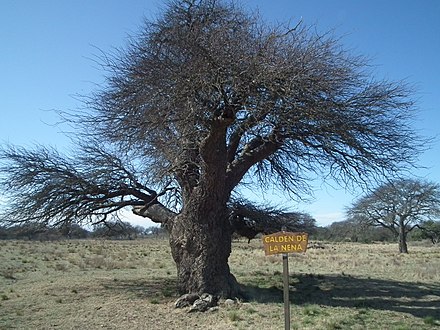La Pampa - province of Argentina
La Pampa is a sparsely populated province in the Pampas region of Argentina.
Cities
- Santa Rosa — an important agricultural center with a few attractions for visitors
- General Pico — a mid-sized city of 50.000 inhabitants in the northern part of the province
- 25 de Mayo — the only significant city in the south-west, at the Colorado river
- Victorica — old quiet town in the north
- General Acha — third city of the province, located in the Valle Argentino area with nice rolling hills
- Casa de Piedra — small town at the shores of a large reservoir, at the limit to Río Negro province, founded in 2004
Other destinations
- Luro Prairie Preserve Originally a hunting ground, this reserve protects the Espinal bushlands. South of Santa Rosa.
- Lihué Calel National Park Also sometimes spelled Lihuel Calel. A small rocky mountain range with plenty of wildlife (Guanacos, foxes etc.) located in the south-east of the province.
Understand

La Pampa is one of the lesser visited provinces of Argentina. It is a mostly agricultural province, with little industry or mining. The most important activity is cattle ranching, but there is also avdairy sector, and cultivation of wheat and other cereals.
For tourists, the most interesting areas are in the south and the west, where the flat agriculture lands slowly make place to rolling hills and dry bush- and woodlands, with the Caldén tree being one of the symbols of the province. There are several saltwater lakes in this area, some of them with good beaches. Hunting tourism is also popular in some areas.
Climate
Being located in the Pampas, the province is dominated by two different types of climates: a temperate one in the east and a semi-arid one in the west. Precipitation generally decreases from east to west and from north to south. Summers can be very hot, with average daytime temperatures of around 30 to 35 degrees Celsius, 40 degrees not being uncommon. Winters are cool to cold, with temperatures between 10 and 15 degrees Celsius and frequent frosts at night.
Get in
The most important routes to enter the province are RN 5, coming from Buenos Aires (613 km to the provincial capital, Santa Rosa), and RN 35, coming from Córdoba (611 km) in the north and Bahía Blanca (327 km) in the south. On both highways there are several buses per day, reaching as far north as San Salvador de Jujuy and as far south as Río Gallegos.
Passenger trains used to connect General Pico, Realicó and Santa Rosa with Buenos Aires. They were suspended in 2015 due to an organizational problem, but are maybe likely to return in the mid-term.
Get around
The main highways are paved. Buses connect the smaller towns with Santa Rosa and General Pico.